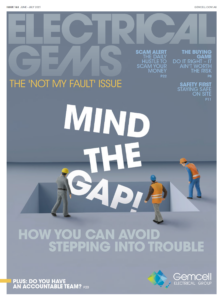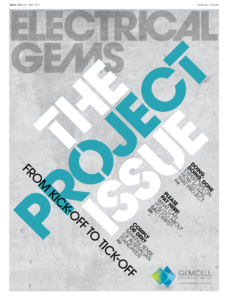Out Now
The Mental Health Issue
Current Issue
The Mental Health Issue
AUG - SEPT 2025

We all encounter change in our professional and personal lives, but why are some changes successful and others not so much?
As a concept, the psychology around change gets a bit of a bad rap.
Mention the word, and people generally get on the back foot. It means a disruption to the status quo. It means things are going to be different. It means there’ll be something new to think about. Or do.
Or maybe the ‘doing’ won’t be there anymore because the change means you’re out of a job.
“As humans, we tend to have this instinctive reaction to change, which is a ‘No, stop it!’, because we’re used to how things are,” says psychologist, author and speaker, Dr Jo Lukins.
“But change is predictable.”
And, there’s the rub. Whoever we are and whatever we do, we all know change – in some form or another – is coming. It’s constant in both our professional and personal lives, and in a 2020 Gartner survey, 75 per cent of people expect change.
So how can something so predictable be feared so much?
“Two things that humans typically don’t like are when life feels out of control and unpredictable, and that’s been a given over the past two or three years,” says Dr Lukins.
Added to that, many changes in the workplace may see new new technology, systems or processes being introduced that changes the day-to-day.
“So initially, there’s greater pain points there for the person.
“And humans don’t like to experience pain. Some people will see the opportunity and what it will bring, and other people get worried and anxious about what the change means.”
Being able to see the opportunity is critically important – and that comes from how the change itself is managed and implemented.
Given that research shows that, in the workplace, about half of change initiatives fail, and only 34 per cent are clearly successful, it doesn’t take Mr Einstein to see the connection.
“There are a variety of factors that can contribute to change not working,” says psychologist, author and Keynote Speaker, Dr Marny Lishman.
“It could be what the change is, how it’s managed by leaders, whether the timing is right for the change and whether the people and organisation as a whole are ready.
“A lot of people actually find change difficult, particularly if it is imposed on them by someone else and they can’t predict the outcome. Often when we embrace change, it’s because we can foresee what the benefits are and feel positive about it. If we feel a lack of control, don’t have enough information and feel uncertain, it’s likely we will resist is as it feels unsafe and uncomfortable.”
When the success or failure of change management is analysed, it has been found that the vision (if there is one) is often drastically under-communicated, short-term wins aren’t identified, and culturally the need for change isn’t well established.
Ultimately, any change in the workplace has to be explained well, given context, and the fear removed.
“You need to have empathy for how people are feeling in the workplace,” says Dr Lishman.
“Many people fear change, so first and foremost is validating how they are feeling.
“Involve other people in the process, so they feel like they are a part of it, feel connected, and allow them to feel a sense of control through the change. Communicate with people as much as you can – the human brain doesn’t like a lack of information – that’s why people make things up or go to worst-case scenarios when they are scared.”
Ultimately, managing change in the workplace isn’t easy – it’s complex and needs deep thought, understanding and empathy.
By having and communicating a clear vision of what the change will enable and understanding the needs of individuals, change can be extremely successful.
If you just change something and let people crack on, however, it will be doomed to failure.
Keep up to date with our latest news and competitions by subscribing to our regular newsletter.

Issue 183
OCT - NOV 2024

Issue 182
AUG - SEPT 2024

Issue 181
JUN - JUL 2024

Issue 180
APR - MAY 2024

Issue 179
FEB - MARCH 2024

Issue 178
DEC 2023 - JAN 2024

Issue 177
OCT - NOV 2023

Issue 176
AUG - SEPT 2023

Issue 175
JUN - JUL 2023

Issue 174
APR - MAY 2023

Issue 173
FEB - MAR 2023

Issue 172
DEC 2022 - JAN 2023

Issue 171
OCT - NOV 2022

Issue 170
AUG - SEPT 2022

Issue 169
JUN - JUL 2022

Issue 168
APR - MAY 2022

Issue 167
FEB - MAR 2022

Issue 166
DEC 2021 - JAN 2022

Issue 165
OCT - NOV 2021

Issue 164
AUG - SEPT 2021

Issue 163
JUN - JUL 2021

Issue 162
APR - MAY 2021

Issue 161
FEB - MAR 2021

Issue 160
DEC 2020 - JAN 2021

Issue 159
OCT - NOV 2020

Issue 158
AUG - SEPT 2020

Issue 157
JUN - JUL 2022

Issue 156
APR - MAY 2020

Issue 155
FEB - MAR 2020

Issue 154
DEC 2019 - JAN 2020

Issue 153
OCT - NOV 2019

Issue 152
AUG - SEPT 2019

Issue 151
JUN - JUL 2019

Issue 150
APR - MAY 2019

Issue 149
FEB - MAR 2019

Issue 148
DEC 2018 - JAN 2019

Issue 147
OCT - NOV 2018

Issue 146
AUG - SEPT 2018

Issue 145
JUN - JUL 2018

Issue 144
APR - MAY 2018

Issue 143
FEB - MAR 2018

Issue 142
DEC 2016 - JAN 2017

Issue 141
OCT- NOV 2017

Issue 140
AUG - SEPT 2017

Issue 139
JUN - JUL 2017

Issue 138
APR - MAY 2017

Issue 137
FEB - MAR 2017

Issue 136
DEC 2016 - JAN 2017

Issue 135
OCT - NOV 2017

Issue 134
AUG - SEPT 2016

Issue 133
JUN - JUL 2016

Issue 132
APR - MAY 2016

Issue 131
FEB - MAR 2016

Issue 130
DEC 2015 - JAN 2016

Issue 129
OCT - NOV 2015

Issue 128
AUG - SEPT 2015

Issue 127
JUN - JUL 2015

Issue 125
APR - MAY 2015

Issue 125
FEB - MAR 2015

Issue 124
DEC 2014 - JAN 2015

Issue 123
OCT - NOV 2014

Issue 122
AUG - SEPT 2014

Issue 121
JUN - JUL 2014

Issue 120
APR - MAY 2014

Issue 119
FEB - MAR 2014

Issue 118
DEC 2013 - JAN 2014

Issue 117
OCT - NOV 2013

Issue 116
AUG - SEPT 2013

Comments (0)
Write a Comment